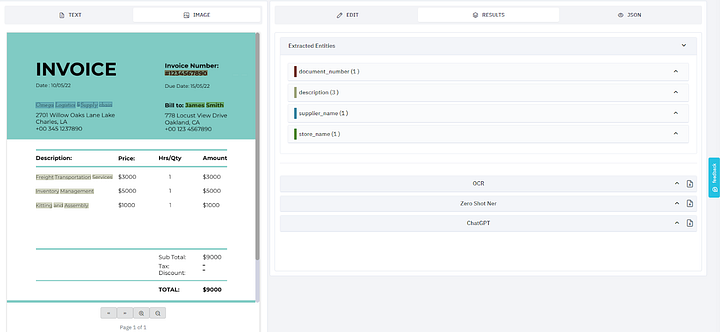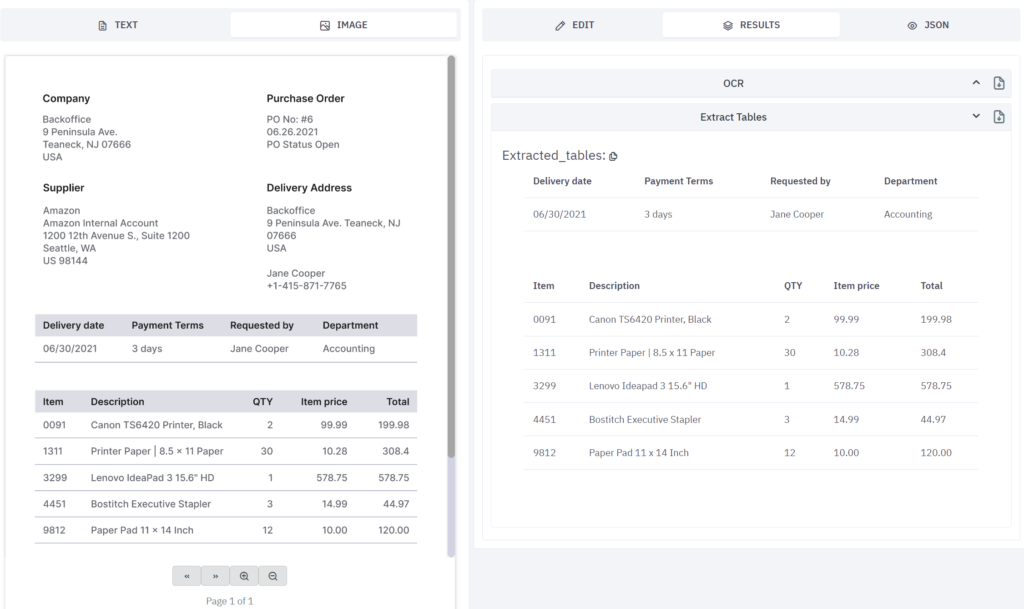The Future of Document Processing in Supply Chain and Logistics Management
Supply Chain
Logistics
AI
SaaS
Invoice Processing
9 min read · Oct 13

Introduction
In today’s fast-paced and interconnected world, efficient document processing is crucial for successful supply chain and logistics management. The traditional manual approach to handling documents can be time-consuming, error-prone, and costly. However, with the advent of AI document processing solutions, the future of document processing in the supply chain and logistics industry is set to be revolutionized.
This article explores the challenges faced by logistics and supply chain businesses in document processing and highlights the benefits of implementing automated solutions.
Understanding The challenges of Supply Chain and Logistics Document Processing

Supply chain and logistics management involves the flow of goods and services from the point of origin to the point of consumption. Throughout this process, various documents are generated, such as invoices, bills of lading, purchase orders, and packing lists.
These documents contain critical information that needs to be accurately captured, analyzed, and shared to ensure smooth and efficient operations.
Invoices:
Invoices are essential documents in the supply chain, as they detail the cost of goods or services provided. These documents often come in various formats, such as paper, PDFs, or email attachments.
One significant challenge is relying on manual data entry for invoice details can lead to errors and delays in payment processing, potentially impacting supplier relationships and cash flow.
Bills of Lading (BOL):
Bills of Lading are crucial documents in the logistics process, as they serve as legal evidence of the contract of carriage and receipt of goods by the carrier.
The challenge with BOLs lies in the meticulous verification of shipment details. Ensuring that the data on the BOL accurately represents the contents of the shipment is time-consuming but essential to prevent shipping errors, disputes, and potential financial losses.
Purchase Orders (PO):
Purchase Orders are documents issued by a buyer to a supplier, specifying the goods or services to be purchased, quantities, prices, and delivery dates.
Matching POs with corresponding invoices and deliveries is a complex and error-prone process. Handling changes to POs and managing revisions efficiently presents another challenge, as these changes can impact inventory management and supplier relationships.
Packing Lists:
Packing Lists provide an itemized account of the contents of a shipment. They are crucial for verifying that the goods received match what was ordered.
The challenge with packing lists lies in the labor-intensive process of physically verifying the contents of a shipment against the list. Handling discrepancies between the packing list and the actual shipment contents can lead to delays in processing and customer dissatisfaction, impacting the efficiency of the supply chain.
→ Each of these documents plays a vital role in supply chain and logistics management, but this traditional approach, while once considered the norm, poses a myriad of challenges that hinder efficiency, accuracy, and overall competitiveness in the modern era.

The key difficulties of manual document processing in supply chain and logistics:
- Human Error: Manual data entry is prone to human error, leading to inaccuracies in records and potential disruptions in the supply chain.
- Time-Consuming: Processing documents manually is a time-intensive process, delaying critical decision-making and slowing down the movement of goods.
- Lack of Visibility: Manual systems often lack real-time visibility, making it difficult to track the status and location of shipments.
- Compliance Risks: Keeping up with changing regulations and ensuring compliance can be challenging without automated systems.
- Cost Inefficiencies: The labor-intensive nature of manual processing can lead to high operational costs.
- Limited Scalability: As supply chain volumes grow, manual processing becomes increasingly impractical and expensive.
- Data Security: Handling sensitive information manually can pose security risks, with documents more susceptible to loss or theft.
- Inefficiency in Collaboration: Manual processing hampers collaboration between different stakeholders in the supply chain, leading to communication gaps.
→ Automated document processing, on the other hand, leverages advanced technologies such as artificial intelligence (AI), machine learning (ML), and optical character recognition (OCR) to automate the extraction and analysis of data from documents.
→ Implementing an automated document processing system can help companies save time and efforts and identify and mitigate supply risks by providing real-time visibility into the status of orders, shipments, and inventory levels.
Introducing Kudra: AI Document Processing Solutions Tailored for the Supply Chain and Logistics Sector

Kudra transforms traditional document processing within the supply chain and logistics sector, breaking free from the old paradigms that typically demand extensive technical team involvement for implementation and maintenance.
Kudra brings forth a new era of simplicity through its intuitive user interface, empowering professionals in the supply chain and logistics field to effortlessly create customized workflows, all without the need for advanced technical expertise.
What Sets Kudra Apart in the Supply Chain and Logistics Sector?
Kudra’s differentiating factor lies in the transformative impact it delivers to supply chain and logistics operations. With the potential to accelerate document processing times by up to 90%, reduce error rates by an impressive 95%, and cut operational costs by as much as 80%, Kudra enables supply chain and logistics teams to redirect their efforts towards core activities such as business expansion and optimizing the seamless flow of goods.
Now, let’s delve into the remarkable features that position Kudra as the ultimate ally in document processing for the supply chain and logistics sector:
Optical Character Recognition (OCR):
Kudra employs advanced OCR technology to extract precise textual data from diverse supply chain and logistics documents, ensuring unparalleled accuracy. This eliminates manual data entry, reducing errors and streamlining document management by transforming physical documents into digital formats.

Table Extraction:
Within the supply chain and logistics, tables often hold vital information. Kudra simplifies table data extraction, converting it into structured digital formats. This enhances data organization and accessibility, empowering teams to work efficiently with tables in a digital environment.

Form Recognizer:
Kudra’s Form Recognizer categorizes elements like product codes, shipping labels, and delivery notes in supply chain and logistics documents automatically. This streamlines document sorting, reduces manual effort, and expedites processes, improving stakeholder interactions.

Classification with LLMs (Large Language Models):
Leveraging LLMs, Kudra precisely classifies supply chain and logistics documents into categories like shipment records, purchase orders, or inventory reports. This enhances document indexing, simplifies access, ensures compliance, and expedites retrieval.

Multiple Export Options:
Kudra offers flexibility by allowing supply chain and logistics professionals to export documents in various formats, including PDF or JSON. This versatility facilitates sharing, archiving, and collaboration based on specific needs, such as presentations, compliance documentation, or archival purposes.

How Kudra Empowers Logistics and Supply Chain Professionals

Tailored Customization:
Kudra’s AI technology adapts to the nuances of your logistics and supply chain industry, optimizing efficiency and reducing time spent on routine document tasks.
Efficiency Boost:
Kudra automates document processes, freeing up your time and resources to focus on core logistics and supply chain activities. This empowers you to nurture business relationships, enhance your operations, and capitalize on growth opportunities.
User-Friendly Workflows:
Kudra’s intuitive interface allows you to create customized workflows effortlessly, without coding skills. This flexibility ensures seamless integration with your logistics and supply chain operations, enhancing efficiency.

AI-Driven Excellence:
Kudra’s AI capabilities continuously improve by learning from your interactions. Corrections, inputs, and new document types enhance accuracy, making Kudra a finely-tuned solution that aligns perfectly with your logistics and supply chain operations.
Introducing Kudra: AI Document Processing Solutions Tailored for the Supply Chain and Logistics Sector

Implementing an automated document processing solution in logistics and supply chain management offers several benefits. Let’s explore some of the key advantages:
1. Enhanced Efficiency and Accuracy
Automated document processing systems, such as Kudra, can significantly improve efficiency and accuracy in logistics operations. By leveraging artificial intelligence (AI) and machine learning (ML) algorithms, these systems can extract relevant data from structured and unstructured documents with high precision. This eliminates the need for manual data entry, reducing human errors and increasing overall accuracy.
2. Faster Document Processing Times
With intelligent document processing, the time required to process and analyze documents is significantly reduced. AI algorithms can quickly scan and extract relevant information from documents, enabling logistics professionals to make faster decisions and respond to customer demands more efficiently.
3. Cost Savings
By automating document processing tasks, intelligent document processing solutions can help reduce operational costs. The elimination of manual data entry and the associated errors can lead to cost savings in terms of time, resources, and potential penalties resulting from inaccuracies.
4. Enhanced Customer Experience
Efficient document processing contributes to a better customer experience in supply chain and logistics management. Faster processing times mean faster order fulfillment and delivery, resulting in improved customer satisfaction and loyalty.
5. Streamlined Inventory Management
Efficient inventory management is crucial for logistics companies to optimize costs and meet customer demands. Automated document processing systems can integrate with inventory management systems, providing real-time visibility into inventory levels, stockouts, and demand patterns. This enables companies to make data-driven decisions and streamline their inventory management processes.
6. Efficient Reverse Logistics
Reverse logistics, the management of product returns, is a critical aspect of logistics operations. Automated document processing systems can streamline the reverse logistics process by automating the handling of return documents, such as return authorizations, shipping labels, and credit memos. This improves efficiency and reduces the processing time for returns, enhancing customer satisfaction.
7. Optimal Transportation Management
Transportation management is a complex task in logistics and supply chain operations. Automated document processing systems can integrate with transportation management systems, providing real-time visibility into shipment statuses, tracking information, and delivery confirmations. This enables companies to optimize their transportation routes, reduce costs, and improve overall customer service.
8. Effective Warehouse Management
Efficient warehouse management is crucial for logistics companies to ensure smooth operations and timely order fulfillment. Automated document processing systems can integrate with warehouse management systems, enabling companies to automate processes such as receiving, put-away, picking, and packing. This reduces manual errors, improves inventory accuracy, and enhances overall warehouse efficiency.
Conclusion: The Future of Document Processing in Supply Chain and Logistics Management
In conclusion, implementing automated document processing systems in logistics and supply chain management can significantly enhance efficiency, accuracy, and cost-effectiveness. These solutions provide real-time visibility into inventory levels, demand patterns, and transportation statuses, enabling companies to make data-driven decisions and optimize their operations.
By leveraging AI and ML algorithms, companies can streamline their document processing workflows, reduce manual errors, and improve overall customer satisfaction.
As the logistics industry continues to evolve, embracing intelligent document processing solutions like Kudra will be crucial for businesses seeking to stay ahead of the competition and achieve operational excellence.
Reach out to us for a free demo and start a journey toward a more efficient, effective, and hassle-free Supply chain document processing experience!